2011 HYUNDAI VERACRUZ 4WD
[x] Cancel search: 4WDPage 256 of 419

519
Driving your vehicle
✽✽NOTICE
Do not drive in water if the level is higher than the bottom of the vehicle.
Check your brake condition once you
are out of mud or water. Press the
brake pedal several times as you move
slowly until you feel normal braking
forces return.
Shorten your scheduled maintenance interval if you drive in off-road condi-
tions such as sand, mud or water (see
“Maintenance under severe usage
conditions” in section 7). Always wash
your car thoroughly after off road use,
especially cleaning the under side of
the vehicle.
Since the driving torque is always applied to the 4 wheels the perform-
ance of the 4WD vehicle is greatly
affected by the condition of the tires.
Be sure to equip the vehicle with four
tires of the same size and type.
A full time four wheel drive vehicle cannot be towed by an ordinary tow
truck. Make sure that the vehicle is
placed on a flat bed truck for moving.WARNING - 4WD driving
Avoid high cornering speed.
Do not make quick steering wheel movements, such as sharp
lane changes or fast, sharp turns.
The risk of rollover is greatly increased if you lose control of
your vehicle at high speed.
In a collision, an unbelted person is significantly more likely to die
compared to a person wearing aseat belt.
Loss of control often occurs if two or more wheels drop off the
roadway and the driver over
steers to re-enter the roadway. In
the event your vehicle leaves the
roadway, do not steer sharply.
Instead, slow down before pulling
back into the travel lanes.CAUTION - Mud or snow
If one of the front or rear wheels
begins to spin in mud, snow, etc.
the vehicle can sometimes be driv- en out by depressing the accelera-tor pedal further; however avoid running the engine continuously at
high rpm because doing so coulddamage the 4WD system.
procarmanuals.com
Page 257 of 419

Driving your vehicle
20
5
E170400AEN E170600AEN
E170700AEN
Full-time 4WD vehicles must be tested on a special four wheel chassis
dynamometer.
✽✽ NOTICE
Never engage the parking brake while
performing these tests.
An 4WD vehicle should not be tested on a 2WD drive roll tester. If a 2WD roll
tester must be used, perform the fol-
lowing: 1. Check the tire pressures recommend-
ed for your vehicle.
2. Place the front wheels on the roll tester for a speedometer test as shown
in the illustration.
3. Release the parking brake.
4. Place the rear wheels on the tempo- rary free roller as shown in the illustra- tion.WARNING - Dynamometer testing
Keep away from the front of the
vehicle while the vehicle is in gear
on the dynamometer. This is very
dangerous as the vehicle can jump
forward and cause serious injury ordeath.
WARNING - Jacked vehicle
While the full-time 4WD vehicle is
being raised on a jack, never startthe engine or cause the tires to
rotate.
There is the danger that rotating
tires touching the ground could
cause the vehicle to go off the jack
and to jump forward.
OCM051013Roll tester (speedometer)Temporary free roller
WARNING
Your vehicle is equipped with tires
designed to provide for safe ride
and handling capability. Do not use
a size and type of tire and wheel
that is different from the one that is
originally installed on your vehicle.
It can affect the safety and perform-
ance of your vehicle, which could
lead to handling failure or rollover
and serious injury. When replacing
the tires, be sure to equip all fourtires with the tire and wheel of the
same size, type, tread, brand and
load-carrying capacity. If you never-
theless decide to equip your vehi-
cle with any tire/wheel combination
not recommended by HYUNDAI for
off road driving, you should not use
these tires for highway driving.
procarmanuals.com
Page 280 of 419
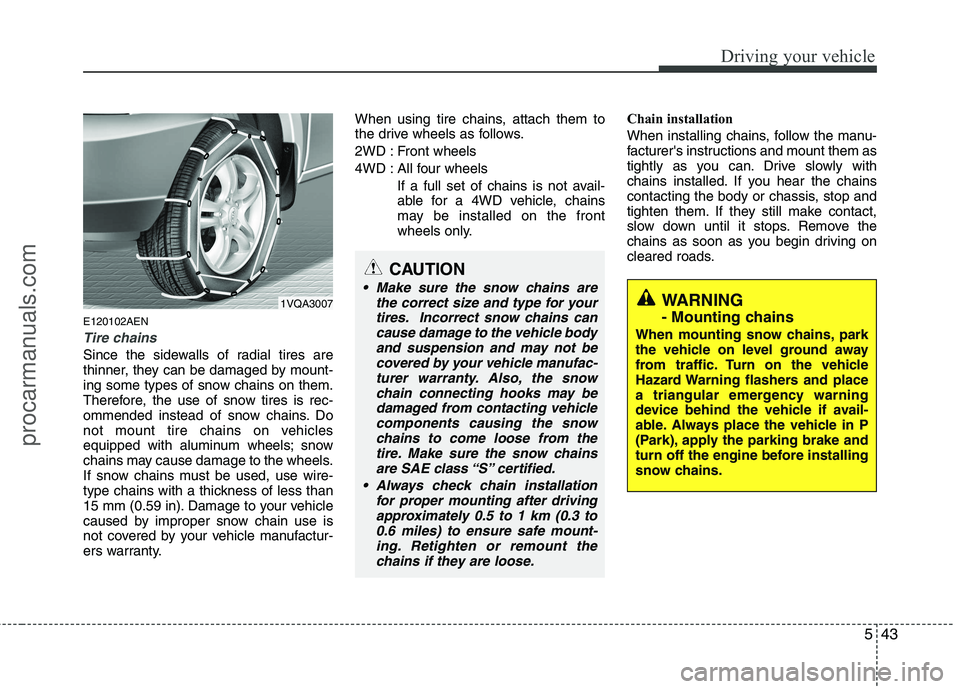
543
Driving your vehicle
E120102AEN
Tire chains
Since the sidewalls of radial tires are
thinner, they can be damaged by mount-
ing some types of snow chains on them.
Therefore, the use of snow tires is rec-
ommended instead of snow chains. Do
not mount tire chains on vehicles
equipped with aluminum wheels; snow
chains may cause damage to the wheels.
If snow chains must be used, use wire-
type chains with a thickness of less than
15 mm (0.59 in). Damage to your vehicle
caused by improper snow chain use is
not covered by your vehicle manufactur-
ers warranty.When using tire chains, attach them to
the drive wheels as follows.
2WD : Front wheels
4WD : All four wheels
If a full set of chains is not avail-
able for a 4WD vehicle, chains
may be installed on the front
wheels only. Chain installation
When installing chains, follow the manu-
facturer's instructions and mount them as
tightly as you can. Drive slowly with
chains installed. If you hear the chains
contacting the body or chassis, stop and
tighten them. If they still make contact,
slow down until it stops. Remove the
chains as soon as you begin driving on
cleared roads.
CAUTION
Make sure the snow chains are
the correct size and type for yourtires. Incorrect snow chains can
cause damage to the vehicle bodyand suspension and may not be covered by your vehicle manufac-turer warranty. Also, the snowchain connecting hooks may be
damaged from contacting vehiclecomponents causing the snowchains to come loose from thetire. Make sure the snow chains
are SAE class “S” certified.
Always check chain installation for proper mounting after drivingapproximately 0.5 to 1 km (0.3 to
0.6 miles) to ensure safe mount-ing. Retighten or remount the chains if they are loose.WARNING
- Mounting chains
When mounting snow chains, park
the vehicle on level ground away
from traffic. Turn on the vehicle
Hazard Warning flashers and place
a triangular emergency warning
device behind the vehicle if avail-
able. Always place the vehicle in P
(Park), apply the parking brake and
turn off the engine before installing
snow chains.1VQA3007
procarmanuals.com
Page 312 of 419
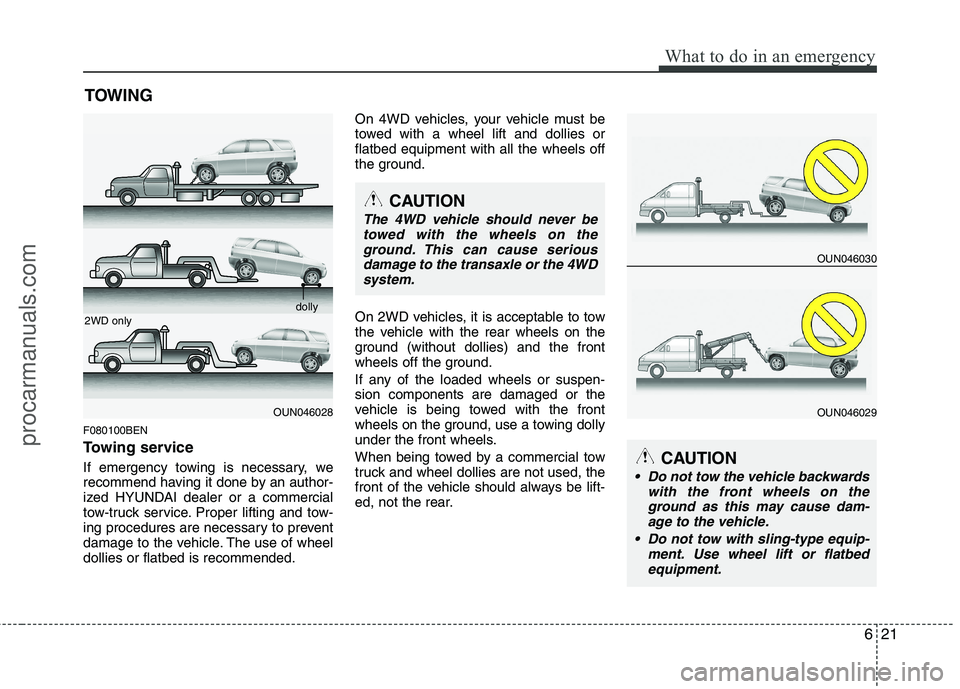
621
What to do in an emergency
TOWING
F080100BEN
Towing service
If emergency towing is necessary, we
recommend having it done by an author-
ized HYUNDAI dealer or a commercial
tow-truck service. Proper lifting and tow-
ing procedures are necessary to prevent
damage to the vehicle. The use of wheeldollies or flatbed is recommended. On 4WD vehicles, your vehicle must be
towed with a wheel lift and dollies orflatbed equipment with all the wheels off
the ground.
On 2WD vehicles, it is acceptable to tow
the vehicle with the rear wheels on the
ground (without dollies) and the front
wheels off the ground.
If any of the loaded wheels or suspen- sion components are damaged or the
vehicle is being towed with the front
wheels on the ground, use a towing dolly
under the front wheels.
When being towed by a commercial tow
truck and wheel dollies are not used, the
front of the vehicle should always be lift-
ed, not the rear.
OUN046028
OUN046030
OUN046029
CAUTION
Do not tow the vehicle backwards
with the front wheels on theground as this may cause dam-
age to the vehicle.
Do not tow with sling-type equip- ment. Use wheel lift or flatbedequipment.
CAUTION
The 4WD vehicle should never be towed with the wheels on theground. This can cause serious
damage to the transaxle or the 4WDsystem.
dolly2WD only
procarmanuals.com
Page 329 of 419
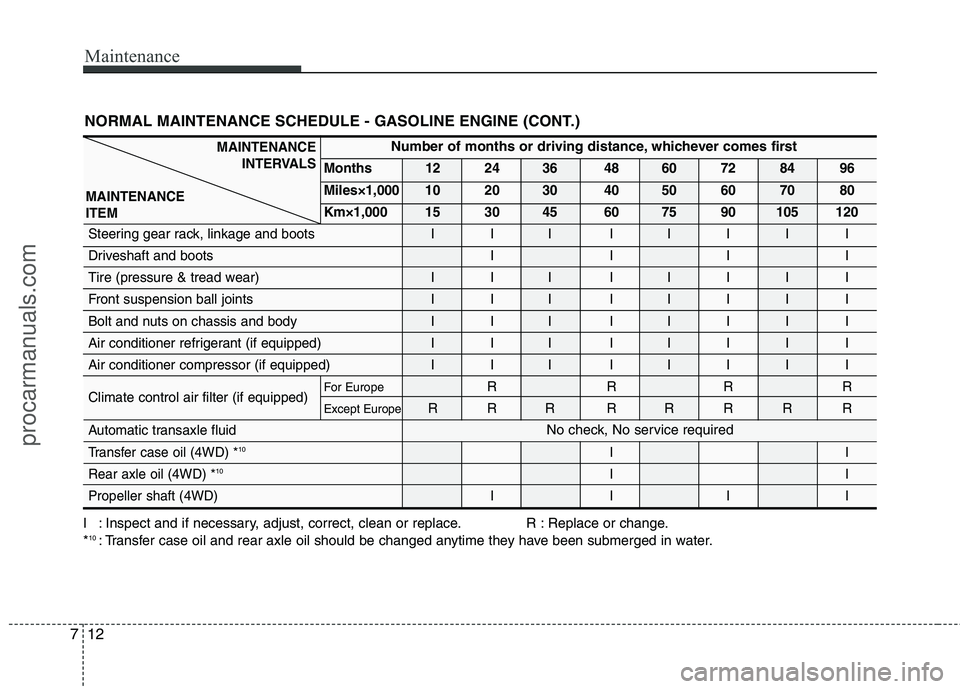
Maintenance
12
7
NORMAL MAINTENANCE SCHEDULE - GASOLINE ENGINE (CONT.)
I : Inspect and if necessary, adjust, correct, clean or replace. R : Replace or change. * 10
: Transfer case oil and rear axle oil should be changed anytime they have been submerged in water.
Number of months or driving distance, whichever comes first
Months 12 24 36 48 60 72 84 96
Miles×1,000 10 20 30 40 50 60 70 80
Km×1,000 15 30 45 60 75 90 105 120
Steering gear rack, linkage and boots I I I I I I I I
Driveshaft and boots I I I I
Tire (pressure & tread wear) I I I I I I I I
Front suspension ball joints I I I I I I I I
Bolt and nuts on chassis and body I I I I I I I I
Air conditioner refrigerant (if equipped) I I I I I I I I
Air conditioner compressor (if equipped) I I I I I I I I Climate control air filter (if equipped)
For EuropeRRRR
Except EuropeRRR RRRRR
Automatic transaxle fluid
Transfer case oil (4WD) * 10
II
Rear axle oil (4WD) * 10
II
Propeller shaft (4WD) I I I I
MAINTENANCE
INTERVALS
MAINTENANCE ITEM
No check, No service required
procarmanuals.com
Page 330 of 419

713
Maintenance
G040200CEN-EE
MAINTENANCE UNDER SEVERE USAGE CONDITIONS - GASOLINE ENGINE
The following items must be serviced more frequently on cars mainly used under severe driving conditions.
Refer to the chart below for the appropriate maintenance intervals.
R : Replace I : Inspect and if necessary, adjust, correct, clean or replaceEngine oil and For Middle East R Every 5,000 km (3,000 miles) or 6 months A, B, C, D, E, F,
engine oil filter Except Middle East R Every 7,500 km (4,500 miles) or 6 months G, H, I, J
Air cleaner filter R C, E
Spark plugs R B, H
Transfer case oil (4WD) R Every 120,000 km (80,000 miles) C, E, G, H, I, J
Rear axle oil (4WD) R Every 120,000 km (80,000 miles) C, E, G, H, I, J
Steering gear rack, linkage and boots I C, D, E, F, G
Automatic For Europe
REvery 90,000 km A, C, D, E, F,
transaxle fluidExcept EuropeEvery 100,000 km G, H, I, J
MAINTENANCE ITEMMaintenance
operation Maintenance intervals
Driving condition
Replace more frequently
depending on the condition
Inspect more frequently
depending on the condition Replace more frequently
depending on the condition
procarmanuals.com
Page 335 of 419
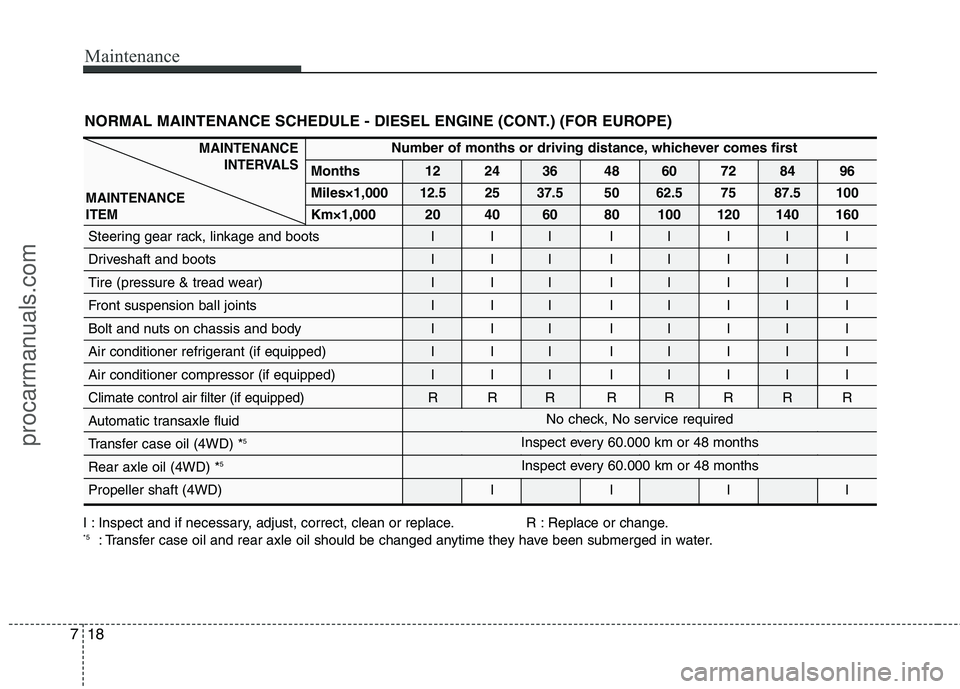
Maintenance
18
7
NORMAL MAINTENANCE SCHEDULE - DIESEL ENGINE (CONT.) (FOR EUROPE)
Number of months or driving distance, whichever comes first
Months 12 24 36 48 60 72 84 96 Miles×1,000
12.5 25 37.5 50 62.5 75 87.5 100
Km×1,000 20 40 60 80 100 120 140 160
Steering gear rack, linkage and boots I I I I I I I I
Driveshaft and boots I I I I I I I I
Tire (pressure & tread wear) I I I I I I I I
Front suspension ball joints I I I I I I I I
Bolt and nuts on chassis and body I I I I I I I I
Air conditioner refrigerant (if equipped) I I I I I I I I
Air conditioner compressor (if equipped) I I I I I I I I
Climate control air filter (if equipped)RRR RRRRR
Automatic transaxle fluid
Transfer case oil (4WD) * 5
Rear axle oil (4WD) * 5
Propeller shaft (4WD) I I I I
MAINTENANCE
INTERVALS
MAINTENANCE ITEM
I : Inspect and if necessary, adjust, correct, clean or replace. R : Replace or change. *5 : Transfer case oil and rear axle oil should be changed anytime they have been submerged in water.
No check, No service required
Inspect every 60.000 km or 48 months
Inspect every 60.000 km or 48 months
procarmanuals.com
Page 336 of 419
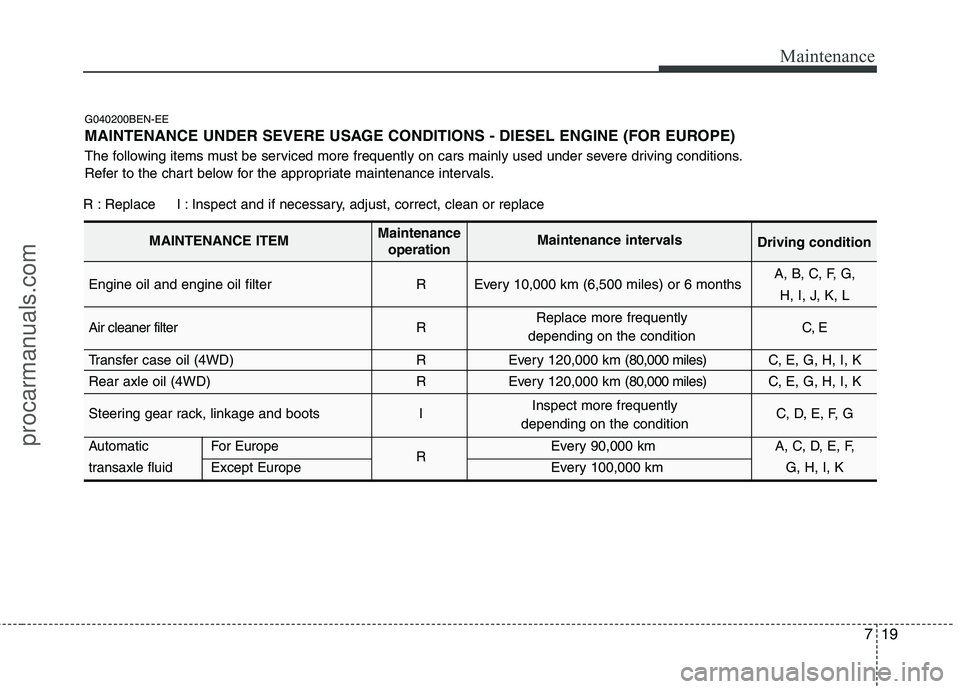
719
Maintenance
G040200BEN-EE
MAINTENANCE UNDER SEVERE USAGE CONDITIONS - DIESEL ENGINE (FOR EUROPE)
The following items must be serviced more frequently on cars mainly used under severe driving conditions.
Refer to the chart below for the appropriate maintenance intervals.
R : Replace I : Inspect and if necessary, adjust, correct, clean or replaceEngine oil and engine oil filter R Every 10,000 km (6,500 miles) or 6 months A, B, C, F, G,
H, I, J, K, L
Air cleaner filter R C, E
Transfer case oil (4WD) R Every 120,000 km (80,000 miles) C, E, G, H, I, K
Rear axle oil (4WD) R Every 120,000 km (80,000 miles) C, E, G, H, I, K
Steering gear rack, linkage and boots I C, D, E, F, G
Automatic For Europe
REvery 90,000 km A, C, D, E, F,
transaxle fluidExcept EuropeEvery 100,000 km G, H, I, K
MAINTENANCE ITEMMaintenance
operation Maintenance intervals
Driving condition
Replace more frequently
depending on the condition
Inspect more frequently
depending on the condition
procarmanuals.com